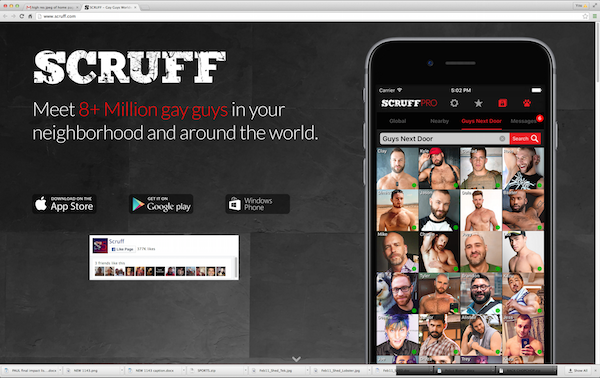
BY GRANT ROTH | I have been on SCRUFF for a little over a year now. In this period, I have met not only guys to hook up with, but also good friends and confidants. The dating app was where I first learned about Pre-Exposure Prophylaxis (PrEP; a daily pill that has proven effective in protecting HIV-negative individuals from acquiring the disease). SCRUFF has also enabled me to chat with guys all across the world about common interests, HIV/AIDS advocacy, and LGBTQ history. I am a member of the Millennial generation. For us, finding information via the Internet, and by chatting with other gay men, is the norm.
Of course, things have not always been this way. My older friends talk about how they found out information about HIV/AIDS and LGBTQ history and culture from their friends, the news media, and their own personal experiences. When they were my age (20), they did not have the same interconnectedness that I have always known. This piqued my interest when I started looking through profiles of SCRUFF. I noticed a stark difference in how Millennials portrayed themselves, compared to the “AIDS Generation” — a term coined by my mentor, Dr. Perry N. Halkitis, to describe the men who came of age during the AIDS crisis (today, these men are in their 50s or older). I wondered how the context from which these two generations of men came influences their online presence.
I could have looked at income, upbringing, hometown, and family dynamics — but this would have involved speaking with many individuals. Instead, I decided to look at characteristics I would be able to glean from a profile without having to do too much digging: age, location, and HIV status. I saw all of these as a crucial part of a SCRUFF user’s identity (on and off of the application), as well as a good way to organize the profiles I came across.
What I found was interesting. For the most part, men of the AIDS Generation tended to be more explicit in terms of sexual preference (e.g., top, bottom, versatile), as well as communicating what they looked for in a partner. They also tended to use more straightforward language, curse words, etc. Millennials, on the other hand, tended to mention sexual preferences less, and put more information about who they are — likes and dislikes, their jobs, etc.
In terms of HIV status, those from the AIDS Generation who were positive tended to mention they were undetectable, while those of my generation were less likely to do so. For the negative (or non-disclosed) members of both generational groups, they did not mention being on PrEP nearly as much as I would have expected, and there was even some PrEP-shaming on a few of the profiles.
Besides seeing how SCRUFF and other geosocial dating apps can be a powerful tools for educating others about PrEP and TasP (Treatment as Prevention; the use of antiretroviral treatment, or ART, to bring the amount of HIV in the blood to undetectable, i.e. almost nontransferable levels), what I suspected regarding context was correct: C. Wright Mills, a pioneering sociologist, coined the term the “sociological imagination,” or the intersection of an individual’s biography with society’s history. This intersection can help us to understand why an individual might act a certain way, given the context in which they grew up and came of age.
Thus, the context in which the AIDS Generation grew up in was, of course, the AIDS crisis. Sex had to be on the down low because of the intense stigma associated with gay sex. Men had to be direct and to-the-point about if they were looking for a top or bottom, and any other sexual preferences.
This contrasts significantly with the young men of my generation, who have grown up knowing that HIV is a perfectly manageable disease. Highly active antiretroviral therapy (HAART, a combination of at least three drugs that suppress HIV replication) was introduced the year after I was born, and, for some Millennials, a couple of years before they were born. Managing to live with HIV has always been a reality — we have never known it as the death sentence it once was. This, I believe, has led to a great deal of complacency and, in some instances, apathy regarding HIV. You contract it? Okay, just take a pill every day and you will be fine.
Therefore, sex, although “taboo” because it is between members of the same sex, has never been fueled with the additional stigma of AIDS that the members of the AIDS Generation felt. Sex, dating, and other romantic activities and interests have become normalized now that, 35 years later, HIV has thankfully become as manageable as it is. Therefore, I wasn’t surprised by what I found after looking at profiles on SCRUFF. The disparity in how the two groups of men presented themselves on social media mirrored their own sociological imaginations.
The next question I looked at was a very simple one: So what? Why does this difference matter? My answer is rather anecdotal, but I believe other members of the gay community would agree. As aforementioned, there has been a lot of complacency and apathy regarding HIV in my generation. The stories of loss, survival, and resilience that members of the AIDS Generation lived are not at the forefront of our minds anymore, as sad as that may be. Conversely, my generation is the future of the LGBTQ community. Its advances, its setbacks, its challenges — these are all things that now rest on us.
Intergenerational dialogue is not only necessary, but also crucial as to not allow anything like the AIDS crisis to ever happen again, and to involve all members in the new fronts of the fight for equality in the post-marriage age. PrEP access is still vastly unequal, the murder rates of transgender women (especially trans women of color) are startling, and ageism still runs rampant in our community.
There is much work to be done. SCRUFF, Grindr, and other geosocial dating applications are very powerful tools to help with these advances. These apps are where I have met members of the AIDS Generation — men whom I have since socialized with and learned so much from (and I would like to believe that they, in turn, learned something from me). We cannot rely on others for education and history lessons about our community. We must be the ones doing the educating ourselves.
Grant Roth is a student at New York University, concentrating in Media, Culture, and Communication.

















